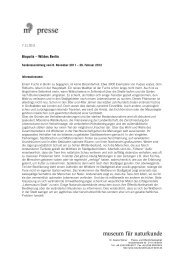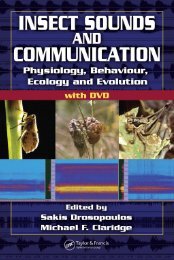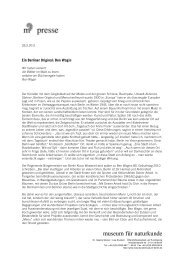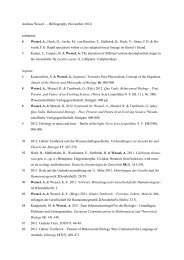Glaubrecht et al 2005.pdf - Download.naturkundemuseum-berlin.de ...
Glaubrecht et al 2005.pdf - Download.naturkundemuseum-berlin.de ...
Glaubrecht et al 2005.pdf - Download.naturkundemuseum-berlin.de ...
Create successful ePaper yourself
Turn your PDF publications into a flip-book with our unique Google optimized e-Paper software.
Mitt. Mus. Nat.kd. Berl., Zool. Reihe 81 (2005) 2 / http://museum-zool.wiley-vch.<strong>de</strong> 151<br />
However, many issues in molluscan phylogen<strong>et</strong>ics<br />
still remain unresolved. Extremely difficult<br />
is the interpr<strong>et</strong>ation of the scarce ontogen<strong>et</strong>ic<br />
data, not only in molluscs in gener<strong>al</strong> but in the<br />
aplacophorans in particular. While for Caudofoveata<br />
only the lecithotrophic larvae of two species<br />
are known (S<strong>al</strong>vini-Plawen 1990, Gustafson<br />
in Nielsen 1995), <strong>de</strong>velopment in Solenogastres<br />
is either lecithotrophic or direct. The ciliated,<br />
free swimming larva in some Solenogastres resembles<br />
superfici<strong>al</strong>ly the so-c<strong>al</strong>led “trochophora”<br />
larva in annelids; for a review of aplacophoran<br />
reproduction and <strong>de</strong>velopment see e.g. S<strong>al</strong>vini-<br />
Plawen (1985). The <strong>de</strong>velopment<strong>al</strong> stages in a<br />
Soleogastres was <strong>de</strong>scribed origin<strong>al</strong>ly as so-c<strong>al</strong>led<br />
“Pruvot larva” by the French m<strong>al</strong>acologist G.<br />
Pruvot (1890). He reported on a late larva (Nematomenia<br />
banyulensis) <strong>de</strong>picting seven rows of<br />
sc<strong>al</strong>es, or “plaques” as he c<strong>al</strong>led it. Although surroun<strong>de</strong>d<br />
by ambiguities and (even after a century)<br />
still in need of further substantiation, this<br />
<strong>de</strong>scription of iterated spicules arrangement has<br />
ever since been interpr<strong>et</strong>ed as being homologous<br />
with a chiton shell, thus fueling the discussion on<br />
the systematic placement of Solenogastres in relation<br />
to polyplacophorans and other Mollusca<br />
(e.g. S<strong>al</strong>vini-Plawen 1972, 1985; S<strong>al</strong>vini-Plawen &<br />
Steiner 1996).<br />
Recently, Scheltema & Ivanov (2002) reported<br />
another neomenioid postlarva exhibiting six iterated,<br />
transverse groups of spicules separated by<br />
seven regions <strong>de</strong>void of spicules which they compared<br />
to the shell fields in <strong>de</strong>veloping polyplacophorans<br />
as well as the sclerite arrangement on<br />
the Cambrian fossils Wiwaxia and H<strong>al</strong>kieria. The<br />
authors suggested, <strong>al</strong>so refering to recent insight<br />
from <strong>de</strong>velopment<strong>al</strong> biology on the function of<br />
regulatory genes, that this iteration (or seri<strong>al</strong> rep<strong>et</strong>ition)<br />
in morphogenesis of ecto<strong>de</strong>rm<strong>al</strong> skel<strong>et</strong>ol<br />
structures in these taxa is a result of processes<br />
<strong>al</strong>ready present in early pre-Cambrian<br />
bilateri<strong>al</strong> anim<strong>al</strong>s and, thus, would indicate evolutionary<br />
relationships among Neomeniomorpha,<br />
Polyplacophora and early P<strong>al</strong>eozoic fossils. They<br />
suggested that these rows of transverse spicules<br />
that appear briefly in the early <strong>de</strong>velopment of<br />
some Solenogastres are expressions of genes that<br />
may be present gener<strong>al</strong>ly in aplacophorans.<br />
However, the authors failed to comment on the<br />
fact that, when assuming these features do actu<strong>al</strong>ly<br />
represent an ancient <strong>de</strong>velopment<strong>al</strong> process<br />
<strong>al</strong>so in early molluscs, then these ecto<strong>de</strong>rm<strong>al</strong><br />
iterations – <strong>al</strong>beit homologues – should be<br />
viewed as plesiomorphic. They would then not<br />
qu<strong>al</strong>ify for supporting an aplacophoran or aculi-<br />
feran assemblage. In ignorance of this it may become<br />
un<strong>de</strong>rstandable that these latter authors, in<br />
context of their new ontogen<strong>et</strong>ic data, again<br />
stress their view that aplacophorans are “<strong>de</strong>rived<br />
molluscs related to chitons and are perhaps progen<strong>et</strong>ic”<br />
(Scheltema & Ivanov 2002: 7).<br />
In summary, recent phylogen<strong>et</strong>ic an<strong>al</strong>yses suggest<br />
that aplacophorans are unlikely to represent<br />
a monophyl<strong>et</strong>ic cla<strong>de</strong>. Instead, among the bas<strong>al</strong><br />
molluscan groups, Solenogastres may be viewed<br />
as the most earliest off-shoot while Caudofoveata<br />
may be closer to the remaining Mollusca (y<strong>et</strong><br />
not as “Hepagastr<strong>al</strong>ia”). However, interpr<strong>et</strong>ation<br />
of character polarity as well as systematics remain<br />
controversi<strong>al</strong>.<br />
Materi<strong>al</strong> and M<strong>et</strong>hods<br />
Some aplacophoran type materi<strong>al</strong> and addition<strong>al</strong> non-type<br />
materi<strong>al</strong> (see section B below) was found by one of us<br />
(L.M.), more or less acci<strong>de</strong>nti<strong>al</strong>ly, during our on-going ev<strong>al</strong>uation<br />
(since 1997) of <strong>al</strong>l molluscan type materi<strong>al</strong>, as it was<br />
long misplaced among opistobranch materi<strong>al</strong> in cabin<strong>et</strong>s of<br />
the M<strong>al</strong>acologic<strong>al</strong> Department in the ZMB. That way, aplacophorans<br />
were at least in part hid<strong>de</strong>n to R. Kilias who started<br />
to publish, among other major gastropod groups (see bibliography<br />
in <strong>Glaubrecht</strong> 2001), <strong>al</strong>so on some minor (i.e. less<br />
speciose taxa) such as e.g. Polyplacophora (Kilias 1995a) and<br />
Scaphopoda (Kilias 1995b).<br />
As we can reconstruct from some notes accompanying this<br />
aplacophoran materi<strong>al</strong>, it was long housed, for the reason of<br />
Thiele’s explicit perception of Solenogastres not being Mollusca<br />
(see review above), in the “Vermes” <strong>de</strong>partment of the<br />
ZMB. Upon investigation we luckily found some other parts<br />
of the aplacophoran type materi<strong>al</strong> there which are now r<strong>et</strong>urned<br />
and housed tog<strong>et</strong>her with Thiele’s origin<strong>al</strong> seri<strong>al</strong> sections<br />
in the M<strong>al</strong>acologic<strong>al</strong> Collection as listed in the compilation<br />
below.<br />
Following sorting and inventarization of this re-discovered<br />
aplacophoran materi<strong>al</strong> done essenti<strong>al</strong>ly by L.M., a list of <strong>al</strong>l<br />
constituent lots was prepared. A first draft of this cat<strong>al</strong>ogue<br />
was sent to LvS-P in Dezember 2002, who agreed to check<br />
and comment on the taxonomic status of these taxa which<br />
was cruci<strong>al</strong> for our en<strong>de</strong>avour. The fin<strong>al</strong> version of the manuscript<br />
was written by M.G. in August 2004, with the inclusion<br />
of the introduction and the historic<strong>al</strong> parts, a review of aplacophoran<br />
classification and its role in molluscan phylogeny.<br />
This version was fin<strong>al</strong>ly again cross-checked in October 2004<br />
by LvS-P.<br />
Based on <strong>al</strong>l combined information available to us then,<br />
we found addition<strong>al</strong> type materi<strong>al</strong> of Thiele’s aplacophorans,<br />
viz. of Neomania grandis, Rhop<strong>al</strong>omenia eisigi and Amphimenia<br />
neapolitana, <strong>al</strong>l <strong>de</strong>scribed by Thiele (1894), but missing<br />
from the ZMB collection, due to research facilitated by <strong>de</strong>cisive<br />
notes of LvS-P ma<strong>de</strong> 1977 in the Zoologic<strong>al</strong> Museum<br />
Amsterdam. It has now, after a long post-WW II odyssee,<br />
r<strong>et</strong>urned to the ZMB; for more d<strong>et</strong>ails see below un<strong>de</strong>r the<br />
species.<br />
Remarks on the origin of the Berlin type materi<strong>al</strong><br />
The type materi<strong>al</strong> that comprises compl<strong>et</strong>e anim<strong>al</strong>s,<br />
histologic<strong>al</strong> seri<strong>al</strong> sections as well as tissues<br />
# 2005 WILEY-VCH Verlag GmbH & Co. KGaA, Weinheim






